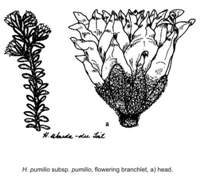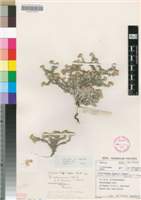Common names:
Wolbossie (A)
Origin of name:
pumilio = dwarf, pygmy, close growing, short
Diagnostic characters:
Densely branched compact grey herbLeaves often overtopping the capitulaBracts straw-coloured, translucent
Description:
Closely branched rounded dwarf shrublet c. 20-200 mm high or sometimes lax and open, taproot thick, woody, main stem gnarled, short, eventually up to 20 mm diam., branches erect or spreading, grey-woolly, densely leafy or sometimes more distantly so. Leaves mostly 4-20 x 1-4 mm, linear-spathulate, apex subacute, apiculate, base narrowed, petiole-like, very shortly decurrent, margins subrevolute, both surfaces thinly to thickly glandular pubescent, glandular hairs usually hidden by persistent grey wool. Heads heterogamous, campanulate, c. 5-6 x (3-) 5-7 mm, sessile, solitary and terminal, often overtopped by younger growth, or solitary on dwarf lateral branchlets, or leaf-opposed and crowded at branchlet tips, or in small terminal corymbose clusters. Involucral bracts in c. 5 series, graded, loosely imbricate, inner about equaling flowers, outermost webbed to surrounding leaves, all semipellucid, often flushed red above the stereome, tips rich golden-brown to palest buff, or whitish, subopaque or innermost pellucid, very acute to acuminate or rarely more abruptly contracted to an acute tip, somewhat squarrose. Receptacle nearly smooth. Flowers 30-96, 6-30 (-51) female, 25-84 homogamous, yellow, sometimes tipped pink. Achenes 0.75 mm, with myxogenic duplex hairs. Pappus bristles many, equaling corolla, scabridulous, bases cohering lightly by patent cilia.
Flowering mainly between August and March.
Distribution:
Favours gravelly or rocky places. A 'Karoo bush', tufted and twiggy or laxer under more favourable conditions, palatable to stock. Recorded, mainly from the arid parts of the Cape, from Namaqualand west to Prieska and extending into the Free State, and south to Laingsburg, Prince Albert Road, Graaff-Reinet and Pearston in the Karoo.
Succulent Karoo and Nama Karoo Biomes.
Notes:
Two subspecies are recognized:
(a) subsp. pumilio (b) subsp. fleckii
Despite differences in facies produced by growing conditions or grazing, the species is easily recognized by its linear-spathulate leaves allied to very acute, more or less squarrose involucral bracts.
Taxonomy:
Literature:
Helichrysum pumilio (O. Hoffm.) Hilliard & Burtt in Bot. J. Linn. Soc. 82: 198 (1981).
Type:
Cape, Beaufort West, 950 m, 6 ii 1894, Kuntze (NY, holo.; K, iso.).
Synonym(s):
Leontonyx pumilio O. Hoffm. in O. Kuntze, Rev. Gen. 3,2: 162 (1898).
Gnaphalium pusillum Thunb., Prodr. 149 (1800), Fl. Cap. 651 (1823), non Haenke (1791). G. nanum Willd., Sp. Pl. 3: 1898 (1803), non Helichrysum nanum Klatt. Leontonyx pusillus Less., Syn. Comp. 327 (1832). Helichrysum pachyrhizum Harv. var. � thunbergii Harv. in F.C. 3: 222 (1865). Type: Cape of Good Hope, Thunberg (sheet 19238, UPS, holo.).
H. bolusianum Moeser in Bot. Jb. 48: 338 (1913). Type: Cape, Prince Albert Road railway station, 600 m, Dec. 1905, Bolus 11972 (BOL, iso.),
H. hutchinsonii Phill. in Ann. S. Afr. Mus. 9: 343 (1917). Type: Cape, Namaqualand, between Steinkopf and the Orange River, near Henkries, Oct.1911, Phillips 1612 (SAM, holo.).
H. laneum S. Moore in J. Bot., Lond. 56: 6 (1918). Type: Cape, Laingsburg, Aug. 1915, Rogers 16760 (BM, holo.; BOL; G; K; P; PRE; Z, iso.).
Vouchers:
Acocks 17708 (K; M; PRE); Barker 7101 (NBG); Galpin 9998 (PRE); Hutchinson 973 (K, PRE); Pillans 14149 (BOL).

